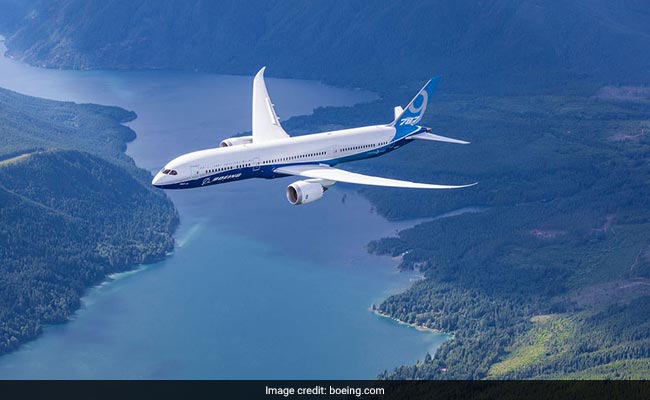Boeing lifted its 20-year forecast for new aircraft demand globally, with about half of the deliveries set to replace older jets with more fuel-efficient models as airlines seek to reduce their carbon emissions.
The Arlington, Virginia-based plane maker expects global demand for 42,595 new commercial jets valued at $8 trillion by 2042, up from 41,170 planes in its previous forecast last year, Boeing said in its latest Commercial Market Outlook.
The global commercial jet market will be buoyed by demand from customers in Asia-Pacific, which represents 22 per cent of global demand. China will make up another 20 per cent.
Single-aisle planes such as the Boeing 737 Max and Airbus A320 Neo will dominate deliveries over the next two decades. New narrow-body planes will account for more than 75 per cent of all new deliveries, up slightly from the 2022 outlook, and totalling 32,420 aircraft.
Low-cost carriers will lead the growth in single-aisle plane deliveries, Boeing said. They will operate more than 40 per cent of the narrow-body fleet in 2042, up from 10 per cent recorded 20 years ago, the outlook report showed.
“The aviation industry has demonstrated resilience and adaptability after unprecedented disruption, with airlines responding to challenges, simplifying their fleets, improving efficiency and capitalising on resurgent demand,” said Brad McMullen, Boeing senior vice president of commercial sales and marketing.
Boeing’s market outlook “reflects further evolution of passenger traffic tied to global growth of the middle class, investments in sustainability, continued growth for low-cost carriers and air cargo demand to serve evolving supply chains and express cargo delivery”.
The growth outlook comes as the aviation industry recovers from the pandemic-induced disruptions over the past three years.
Despite constraints caused by labour shortages, supply chain issues and operational restrictions at airports, passenger traffic is expected to return to pre-pandemic levels in 2024, according to industry estimates.
The optimism echoes a similar sentiment by Boeing’s European rival Airbus which released its own global market forecast last week. Airbus also raised its aircraft delivery projections, estimating that 40,850 new jets would be handed over to customers through until 2042, up from 39,490 deliveries in its previous forecast.
Boeing predicts the global aircraft fleet will double in size to more than 48,500 jets during the next two decades, up from about 24,500 planes in 2022. This is also higher than last year’s outlook in which the company forecast a global fleet of 43,470 aircraft in 2041.
Of the 48,575 jets in the global fleet by 2042, 21,000 will replace older aircraft, and the remainder will account for growth.
Industry-wide passenger traffic growth of 6.1 per cent will outpace the global economy’s expansion of 2.6 per cent through until 2042, according to the outlook.
“Air travel is forecast to continue growing faster than global economic activity driven by tourism demand and increased service levels, particularly in developing markets,” Boeing said.
The growth in the world’s middle-income households also supports air travel demand, bringing another 500 million people into the middle class and making them potential air passengers, it said.
About 90 per cent of this growing middle-income class will be in emerging markets, leading to higher air passenger traffic growth in these areas.
Middle East outlook
Boeing expects Middle East customers to receive 3,025 plane deliveries over the next two decades, slightly up from the 2,980 new planes in last year’s forecast, driven by growing demand for widebody aircraft.
The region’s total fleet will grow to 3,360 aircraft by 2042, one per cent less than last year’s estimates, due to a forecasted productivity increase in terms of aircraft use and load factors, Boeing said.
Global air freight
Robust demand for dedicated cargo freighters will continue, despite the cyclical nature of this sector, due to growing e-commerce and evolving supply chain networks, Boeing said.
Air cargo will continue to outpace global trade growth, with airlines requiring 2,800 dedicated freighters. This includes more than 900 new widebodies as well as converted narrow-body and widebody models.
Deliveries will include 1,810 regional jets and 925 freighters over the next 20 years.
Commercial services
Boeing also expects a global commercial services market worth $3.8 trillion by 2042. This includes digital services, demand for plane parts, growing maintenance and modification needs and training to enhance safety and support the talent pool of pilots and technicians, it said.
Maintenance, repair and overhaul make up 70 per cent of the total $3.8 trillion commercial services market.
The growth and replacement of the global fleet will drive demand for these services and aviation workers.
About 2.3 million new aviation workers will be needed worldwide in the next 20 years, with 13 per cent of that global labour demand coming from the Middle East and Africa region.
Globally, airlines will spend roughly $200 million on training and professional services over the next two decades to replace retiring personnel and support industry growth, Boeing said.


